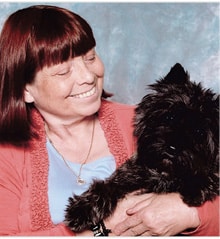Interview with Pat Joyce, Terrier Group AKC Judge
Where do I live? How many years in dogs? How many years as a judge?
Pat Joyce: I currently live in the Atlanta Metro area. I got my first Cairn in 1983 and have had the breed ever since. I went to stock shows with friends in 4-H in Texas long before I first attended a dog show, let alone exhibited in one. So, I came to judging dogs very late in life. At least the dog that does not win at a dog show gets to go home. Much better to be a dog!
Do I have any hobbies or interests outside of purebred dogs?
Pat Joyce: I am a retired MD specialist in Infectious Disease and Tropical Medicine. The CDC was my last posting in government service, after decades where I travelled extensively overseas in a job I loved. I enjoy teaching and continue to lecture in zoonotic diseases for graduate public health programs. I have a strong interest in canine health and have contributed articles for the CTCA Highlander and the Cairn breed column in the AKC Gazette.
What is my original breed? What is/was my kennel name?
Pat Joyce: I sat in my local public library and picked the Cairn out of the AKC Dog Book 40 years ago. I wanted a smart, social, healthy breed that was relatively low maintenance and able to live in any environment. My first Cairn flew with me to the Philippines and back while I worked overseas doing medical research for the US government.
My kennel name is “Connacht” from the rugged Irish province which includes the Western counties from where all Joyces originate. These are the “highlands” of Ireland instead of Scotland.
Have I judged any Terrier Breed/Group Specialties?
Pat Joyce: Although I am relatively “new” to judging, my dedication to working Terriers has been noted by my mentors. I have judged specialties for American Staffordshire and Parson Russell Terriers. I will judge my first Cairn Terrier specialty in December.
Do I have any thoughts on the status of so many Terriers as “low entry” breeds?
Pat Joyce: So many breeds developed in the British Isles because Terriers were local working dogs. No farmer or crofter kept a dog unless it performed a function for the farm and family. Each locality inbred their dogs until the Terrier breeds were developed. My readings on genetic diseases in Terriers have shown me how the farmer’s original selection of which dogs to keep separated the Terriers genetically into their many breeds. Terriers are threatened by the low numbers and by humans forgetting that they were chosen as working dogs that had very specific jobs on the farm.
What about the overall quality of Terriers at all-breed shows? Do low entries mean low quality?
Pat Joyce: I have seen mixed quality. Overgrooming and lots of product frequently hides the dog underneath, in my humble opinion. But I have also seen outstanding specimens that conform to the breed standard and can do the jobs that working Terriers were meant to do.
Are there areas of the country where Terriers are particularly strong? Any areas where they are in trouble?
Pat Joyce: I started my Terrier Group education studying Welsh, Parson Russell, and Australian Terriers because they are hardly low entry in the Southeast. We have excellent quality dogs in this area. Bull Terriers are also particularly strong. Cairns are of excellent quality in the Northeast, North Central, and along the Pacific Coast, although the styles of Cairns differ in these areas.
Do Terriers provide a challenge for judges who come from breeds in the other Groups?
Pat Joyce: I think, yes. Terriers are working dogs and need the same structural soundness as desired in the Sporting or other Groups. Most Terriers are smaller dogs but need correct bone structure and angles as any dog with longer legs. I think that judges must develop an eye for movement in short dogs that still need to cover ground effortlessly.
Have there been judges who have influenced my decision to judge? Influenced my manner of judging?
Pat Joyce: The late and great Ric Chashoudian gave me my first lessons in evaluating dogs. We met in his front yard in Baton Rouge and watched puppies running loose in a large fenced area. Ric taught me to sit back and quietly watch dogs move. His method to observe movement while the dogs moved freely became my starting point as a future judge. Ric could notice more detail about a dog by a few moments of observation than anyone I have ever known.
I also was fortunate to attend Pat Trotter’s movement seminar where I learned to systematically describe what I saw. Both are outstanding mentors for someone wanting to evaluate dogs.
If I could share my life with only one Terrier breed, which breed would it be and why?
Pat Joyce: I will always have Cairns, but other Terriers could be fun. Staffordshire Bulls have wonderful, loving personalities. Australians and Borders are also great company.
Do I have a “Montgomery Memory” that best summarizes my feelings about Terriers in general?
My Cairns love the years when the show is affectionately called “Mudgomery” after heavy rains soak the grounds. We humans are cursing as our feet sink deep and shoes are left behind stuck in the mud. The Cairns, however, are always in their natural element, bouncing happily across the soggy, wet field as if they were in Scotland.
Just for laughs, do I have a funny story that I can share about my experiences judging the Terrier Group?
Pat Joyce: I judged an apprehensive Norwich puppy once that looked up at me from the table with uncertainty. I spoke to the dog in a soothing voice saying, “What’s the matter with you today, darling?” I was startled when the dog’s handler said, “Judge, are you talking to me or the dog?” Then he smiled at me and laughed. Terriers seem to naturally sense I am a committed dog person.









